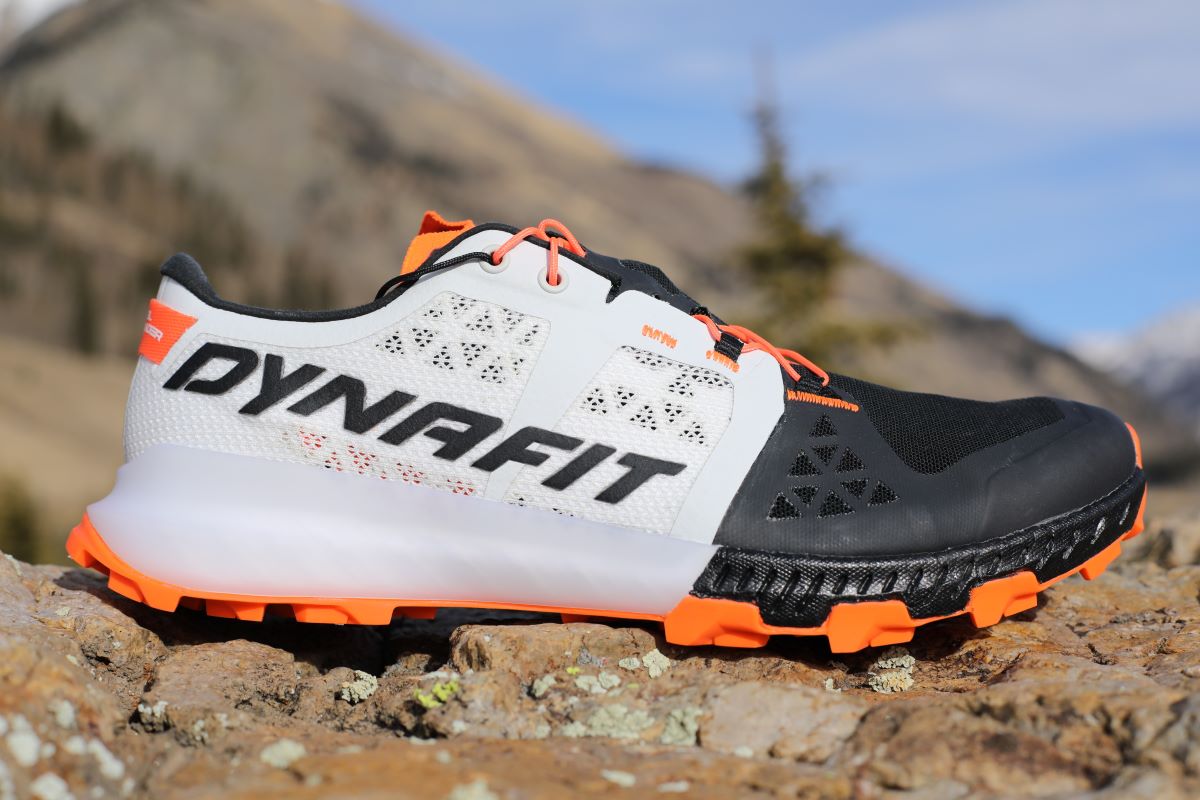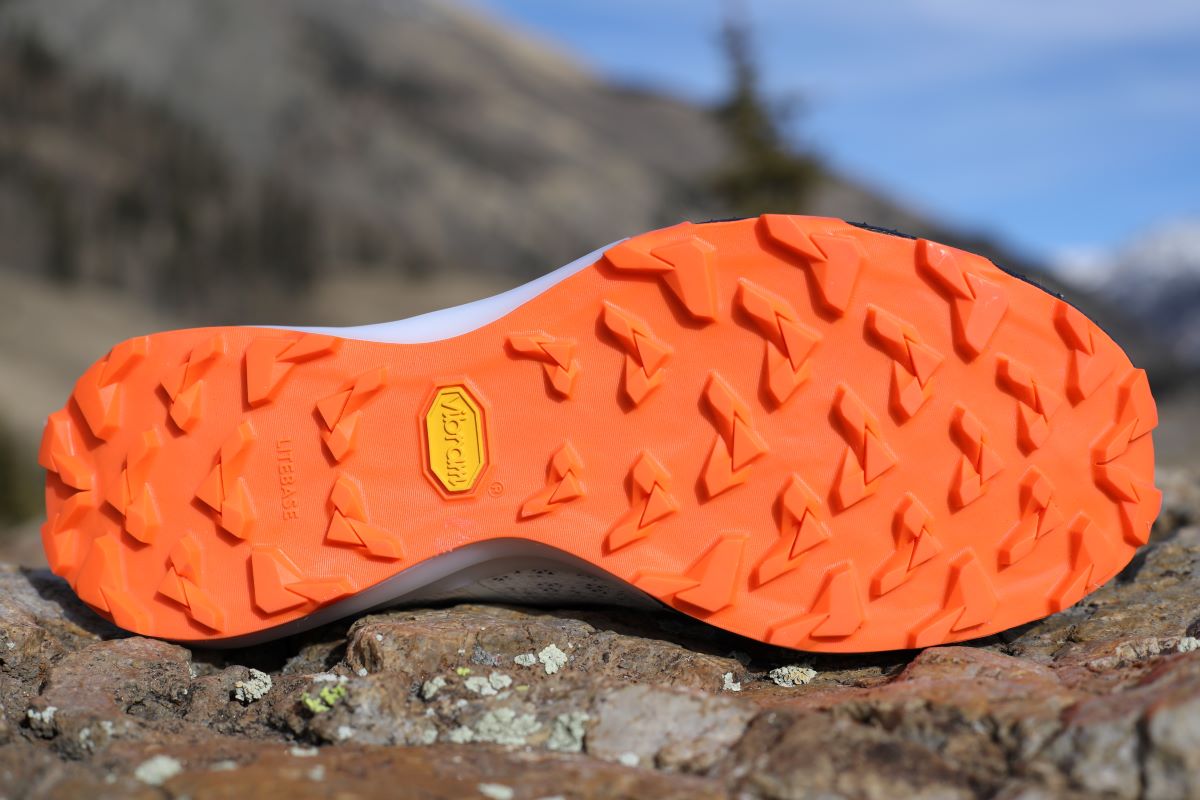Yes, I excitedly welcome the Dynafit Sky DNA ($180) shoe into my quiver with great intrigue and inspiration. All I want to do is speed lace up these featherweight performance shoes and make my way to the starting line of a technical mountain race.
Even though there are a couple of variables that could be fine-tuned, Dynafit has designed a stellar mountain shoe in the Sky DNA for the runner who wants to race, achieve speed, and/or just feel confident on rugged mountain singletrack. It is an arrow for a race bullseye. Besides the VJ Ultra (our VJ Ultra 2 review) I haven’t worn a trail shoe in a while that makes me act like a puppy before a trip to the local trails. There is just so much exhilaration in my feet and body when I slip on the Dynafit Sky DNA.
Dynafit knows the mountains. It knows unpredictable rocky terrain. Dynafit originally started and remains an upper-echelon Austrian ski boot company with wide-ranging success in downhill skiing, ski touring, and mountaineering. A little over a decade ago, it stepped into the trail running scene offering shoes that withstand the test of ruggedness. Their motto, “By Athletes, For Athletes,” reminds the wearer that their footwear has been mindfully and strategically designed for optimal performance in the mountains.
The Dynafit Sky DNA does come with a hefty price tag of $180, but as the consumer is witnessing, newer running shoes are creeping up the cost ladder. A quick comparison across some of the most popular mountain running shoes from other brands shows that Dynafit actually falls on the lower end. Additionally, the technology and materials used in their shoes make them a worthwhile investment.
The Sky DNA is a responsive 4-millimeter drop, 19-millimeter stack height, uncompromising performer, with great ground feel and energy return. The rocker design and lightness — it has an actual weight of 9.2 ounces (260 grams) for a men’s size 9 — promote high cadence and confident midfoot landings overall, compared to bulkier maximalist running shoes. Despite its minimal feel, it still provides decent underfoot protection.
Shop the Women's Dynafit Sky DNAShop the Men's Dynafit Sky DNA
Dynafit Sky DNA Upper
If I may opine, I think the pink and black color combination used for the women’s version of the Dynafit Sky DNA is rad. It has just the right amount of flash, and the orange colorway of the men’s version pictured in this review is also pretty eye-catching.
The upper material is lightweight, as is everything on a shoe optimally designed for speed. More specifically, the upper consists of a soft black tight mesh at the forefoot surrounded by protective thermoplastic polyurethane (TPU) inlaid with a series of triangular-shaped breathability points at the base of the toes. The rest of the shoe is wrapped in a tougher plastic open mesh that covers the soft black internal mesh — creating a double-layer mesh system without compromising drainage or breathability.
As the thin plastic mesh wraps around the heel, it covers a rigid yet minimal heel cup that is simple and not overly constructed. A TPU strap integrated at the base of the shoe diagonally slings around the heel and functions as a secure lockdown and what Dynafit refers to as a “heel preloader” for energy transfer through the gait cycle. The inside of the heel consists of nice felt material for a modicum of softness. Additionally, there are two overlays strategically placed on either side of the shoe for gait integrity and for upper material transition points. The shoe comes with what is called a “volume reducer” to enhance reactivity, but it is also simply an insole.
The fully integrated abrasion-resistant soft mesh integrates across the shoe to form the small lace pouch over the tongue. I will come back to the pouch in a moment. Unfortunately, the lateral inner mesh came unglued to its TPU overlay after only 25 miles of running. The disconnection only occurred in the right shoe, and the left shoe is completely intact and unaffected. The ungluing is only a minor inconvenience but something that shouldn’t happen in this caliber of shoe.
An attractive highlight of the Sky DNA is the Double Speed quick lace system. It is genius, but it needs a little more attention. As a former triathlete, using quick-release shoe laces was imperative for dynamic and efficient transitions. Historically, all my road running shoes were stripped of traditional tie laces for quick laces. It just makes sense when swiftness and efficiency are primary goals.
I love that Dynafit integrated this lacing system into the Sky DNA design. However, I struggle to figure out the best way to store the excess laces once I find the desired cinch fit. The lace pouch seems undersized for storing the excess lace strings properly. I tried my best, but if I couldn’t get a secure fit, I would slip the lace ends underneath the external laces. Furthermore, the tongue is soft and not gusseted, which sometimes results in some migration throughout the run, but nothing that caused concern or resulted in rubbing points. Since the tongue is free, small pieces of granite and dirt often find their way into the shoe. Hooray for a Double Speed quick lace system to simply dump and go.
Dynafit Sky DNA Midsole
A fundamental component of the Dynafit Sky DNA’s performance and ultralight feel is its midsole construction. The midsole is smartly designed with Pebax reactive midsole technology, which is approximately 30% lighter than traditional EVA foams used in many trail running shoes. This advanced material integration is a huge benefit for mountain racers and sky runners. The base thermoplastic material abounds with benefits to the runner, and it increases the overall quality of the shoe. Other shoe companies like Nike and Reebok have hit the ground running with Pebax technology, sometimes touting increased running efficiency and faster running results. Dynafit designers and engineers also have ample experience with Pebax and its many benefits since it is also widely used in their technical ski boots.
An overarching benefit of Pebax technology is its ability to maximize energy return and maintain durability. The thermoplastic-based foam is advantageous because it has a lower density than most other thermoplastics used in running shoes, and it is ultralight, flexible, and highly compressible. These were evident in every run test outing — across snow, ice, technical trail, and easy buttery Southern Oregon granitic dirt. One of the best things I like about the combination of a low drop and this midsole foam is the energy return. Not every minimalist shoe can deliver that return on investment, which often leaves the lower legs and runner exhausted. This is not the case with the Sky DNA. Minimal construction and low drop herein retained great ground feel and responsiveness. Maybe that volume reducer does help.
Dynafit Sky DNA Outsole
The Dynafit Sky DNA features a Vibram Litebase Megagrip outsole, which I have praised before and will praise again. The addition of a Litebase outsole is a savvy decision by shoe designers when speed, performance, and technical terrain are on the line. Since the Sky DNA is a technical mountain racer, designers had to effectively construct a minimal yet secure outsole without compromising the integrity of the underfoot ground feel. The outsole is “lightness without compromise.” Vibram’s slimmed-down outsole seeks to keep the characteristics of its original rubber grip, durability, and traction with a 30% reduction in weight.
I feel confident about my overall traction and the Sky DNA’s ability to withstand any sort of terrain and weather conditions. One of the great things about testing shoes in the winter is the variability of conditions to run. I tested this shoe in the rain, snow, ice, decomposed granite, and rocks. The outsole performed. It gripped. The moderately spaced and multi-directional triangular-shaped lugs, coupled with a stable rocker, ensured landing security.
Dynafit Sky DNA Overall Impressions
It is an absolute blast having the Dynafit Sky DNA as a go-to this winter. After a long day of work — peopling — it is essential for my sanity to cinch up the Double Speed quick lace system, find a spot for those extra laces, and hit the wet local trails — even if it is only for four or five miles before family time commences. The overall feel of the shoe promotes excitement, quickness, and agile midfoot turnover with an exacting ground feel. It is such a great feeling to experience lightness and peppiness while training during these long winter months.
Later this year, I have ambitions to sign up for an adventure swim-trail run. I think the Sky DNA will be a great shoe to test the pool/lake to trails transition. The shoe has ample drainage, is ultra-lightweight, and, as mentioned, offers exceptional energy return. Despite some minor flaws with construction and design, they weren’t deal breakers to how exceptional the Dynafit Sky DNA rides.
This shoe simply makes me smile and feel fast and eager for race season — a feeling I thought I had lost.
Shop the Women's Dynafit Sky DNAShop the Men's Dynafit Sky DNA
Call for Comments
- Have you run in the Dynafit Sky DNA? What were your thoughts?
- What is your go-to shoe for technical mountain racing?
[Editor’s Note: If you’re affiliated (i.e., an employee, ambassador, etc.) with a brand, please share your relation in each of your comments on this article. Thanks!]
Our Favorite Trail Running Shoes
Check out our Best Trail Running Shoes article to learn about our current favorite trail running shoes!





